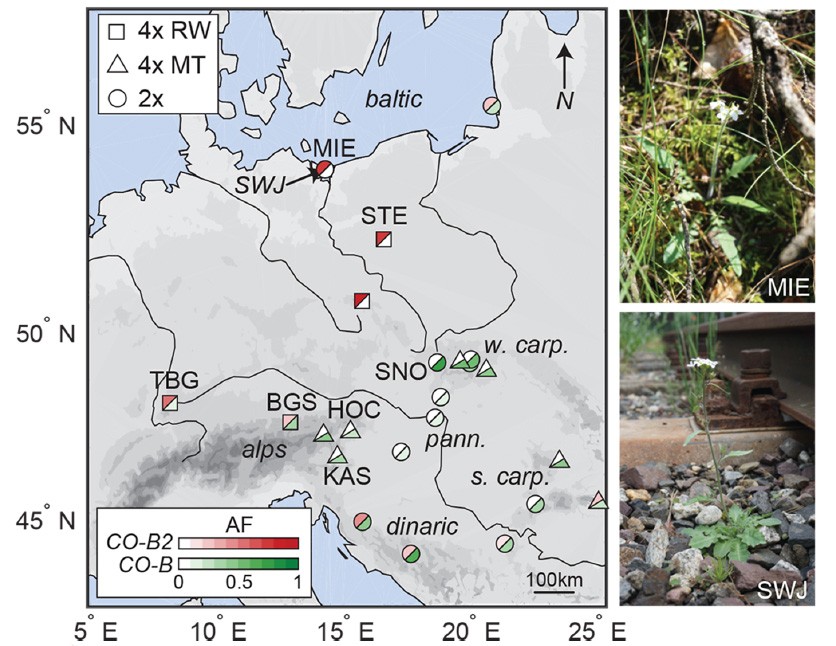博文
PLOS Genetics:拟南芥属物种在人类活动区的演化遗传基础
||
Genetic basis and evolution of rapid cycling in railway populations of tetraploid Arabidopsis arenosa
First author: Pierre Baduel; Affiliations: Harvard University (哈佛大学): Cambridge, USA
Corresponding author: Kirsten Bomblies
Spatially structured plant populations with diverse adaptations provide powerful models to investigate evolution. Human-generated ruderal habitats (杂草生境) are abundant and low-competition, but are challenging for plants not adapted to them. Ruderal habitats also sometimes form networked corridors (e.g. roadsides 路旁 and railways 铁路) that allow rapid long-distance spread of successfully adapted variants. Here we use transcriptomic and genomic analyses, coupled with genetic mapping and transgenic follow-up, to understand the evolution of rapid cycling during adaptation to railway sites in autotetraploid (同源四倍体) Arabidopsis arenosa. We focus mostly on a hybrid population that is likely a secondary colonist of a railway site. These mountain railway plants are phenotypically similar to their cosmopolitan (全球的) cousins. We thus hypothesized that colonization primarily involved the flow of adaptive alleles from the cosmopolitan railway variant. But our data shows that it is not that simple: while there is evidence of selection having acted on introgressed alleles, selection also acted on rare standing variation, and new mutations may also contribute. Among the genes we show have allelic divergence with functional relevance to flowering time are known regulators of flowering, including FLC and CONSTANS. Prior implications of these genes in weediness and rapid cycling supports the idea that these are “evolutionary hotspots” for these traits. We also find that one of two alleles of CONSTANS under selection in the secondary colonist was selected from rare standing variation in mountain populations, while the other was introgressed from the cosmopolitan railway populations. The latter allele likely arose in diploid populations over 700km away, highlighting how ruderal populations could act as allele conduits and thus influence local adaptation.
能够多样化适应的空间结构植物群体对于研究植物演化是很好的一个平台。人类活动所产生的杂草生境分布非常广且内部竞争性较低,但对于不适应该环境的植物非常具有挑战性。杂草生境时常会形成网络化的狭长地带,比如路旁与铁路,使得成功适应的变种的长距离扩散成为可能。本文采用转录组和基因组分析技术,同时偶联遗传作图和转基因跟踪,对同源四倍体拟南芥属物种Arabidopsis arenosa对于铁路环境适应过程中的快速循环演化进行研究。山区铁路植物与其分布全球的近缘种的表型十分相似。因此,作者先假设植物的殖民首先涉及到全球铁路变种适应性等位基因的基因流。但是,本文的研究显示情况并不这么简单,有证据显示选择发生在渗入基因上,同时也发生在罕见的变异上, 新的突变也参与其中。这些基因中,一些与开花时间相关的基因存在等位基因分化,包括FLC和CONSTANS基因,是植物开花的调控子。这些基因表明相关的性状可能是演化热点。作者还发现CONSTANS基因的两个等位基因中的一个选择于山区群体的罕见变异,另一个来自于铁路群体的基因渗入。后者的等位基因在远隔700km的二倍体群体中可能会出现,说明了杂草群体可以作为等位基因通道,进而影响区域性适应。
通讯:Kirsten Bomblies (https://www.jic.ac.uk/directory/kirsten-bomblies/)
个人简介:1996年,宾夕法尼亚大学,学士;2004年,威斯康星大学,博士。
doi: https://doi.org/10.1371/journal.pgen.1007510
Journal: PLOS Genetics
Published date: 05 July, 2018
(P.S. 原文下载:链接:https://pan.baidu.com/s/1qFiSsqwlF_7JjmGMbedfhQ 密码:dmu6)
https://blog.sciencenet.cn/blog-3158122-1122842.html
上一篇:New Phytologist:甲烷菌占美洲黑杨心材微生物群落主要组成部分
下一篇:the plant journal:苹果MYB转录因子调控花青素生物合成
全部作者的其他最新博文
- • Plant Physiology:CsMADS3促进柑果中的叶绿素降解和类胡萝卜素合成(华中农业大学)
- • Molecular Plant:LBD11-ROS反馈调节作用于拟南芥的维管形成层增殖和次生生长(浦项科技大学)
- • Science Advances:根结线虫通过调控植物的CLE3-CLV1模块,促进侵染进程(日本熊本大学)
- • Nature Communications:油菜素内酯参与植物营养生长期转变的分子机制解析(浙江农林大学)
- • Current Biology:光合作用产生的蔗糖驱动侧根“生物钟”(德国弗莱堡大学)
- • PNAS:花同源异型基因在叶中被抑制、花中被激活的分子机制(南卡罗来纳大学)


